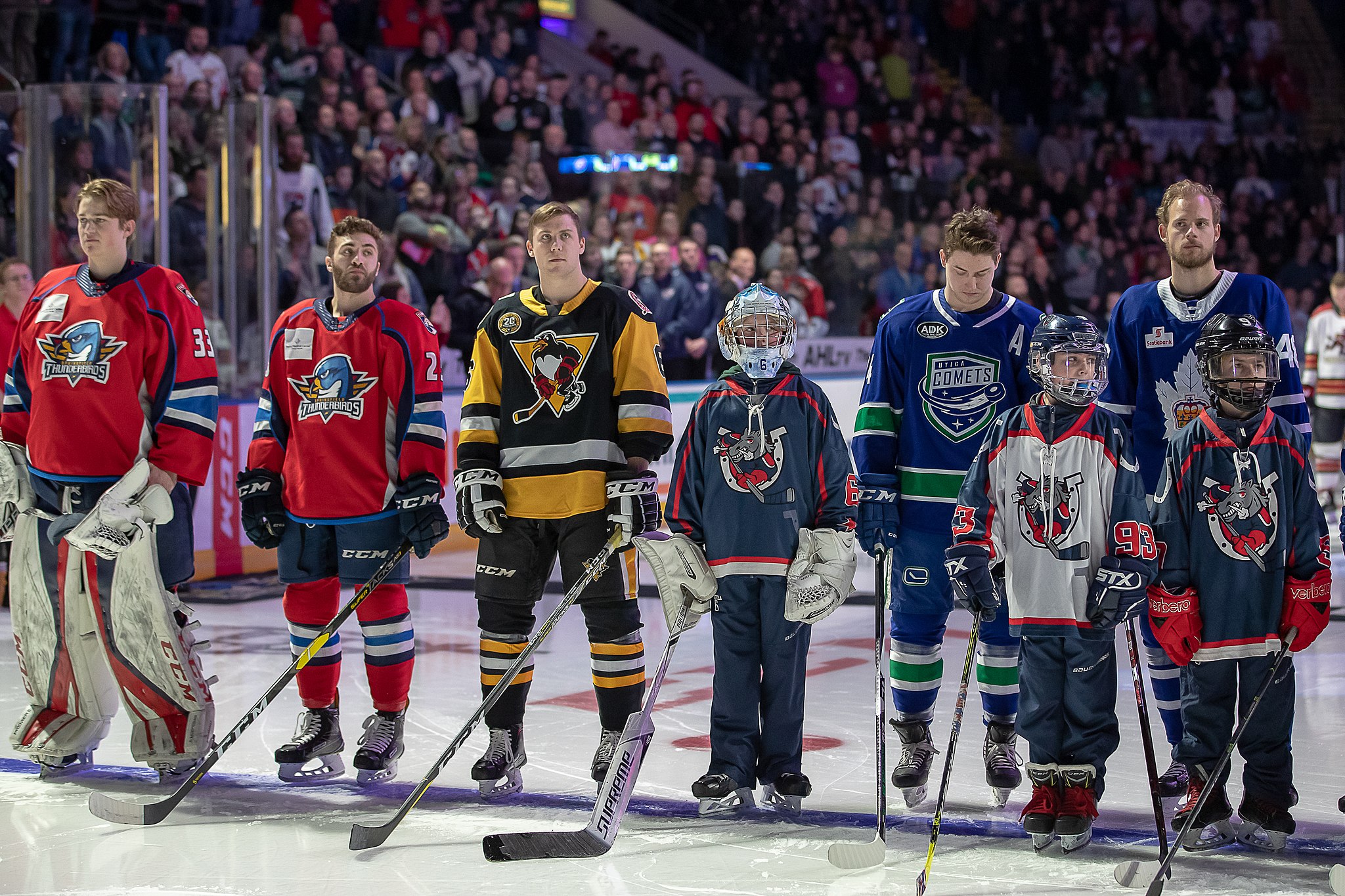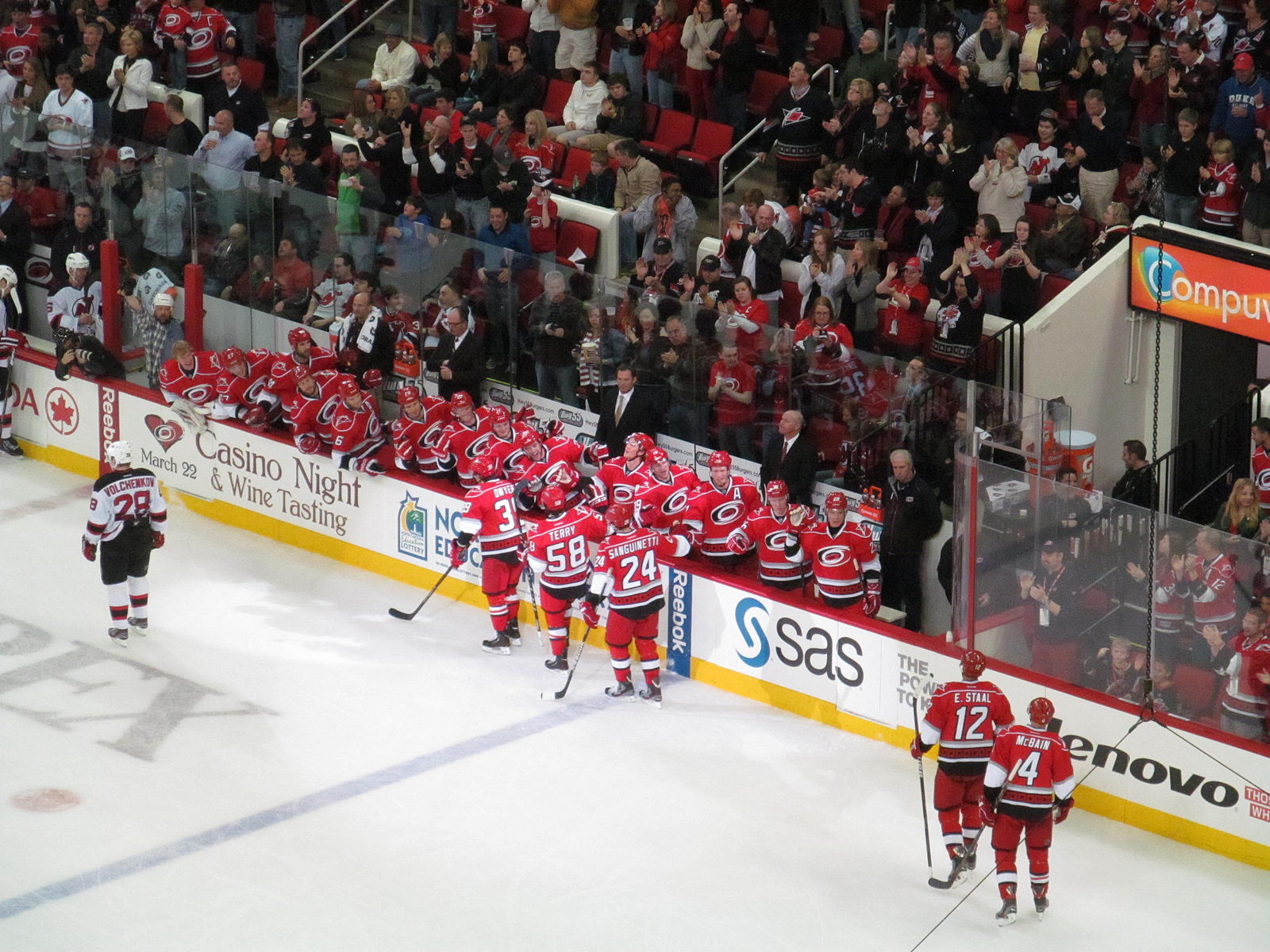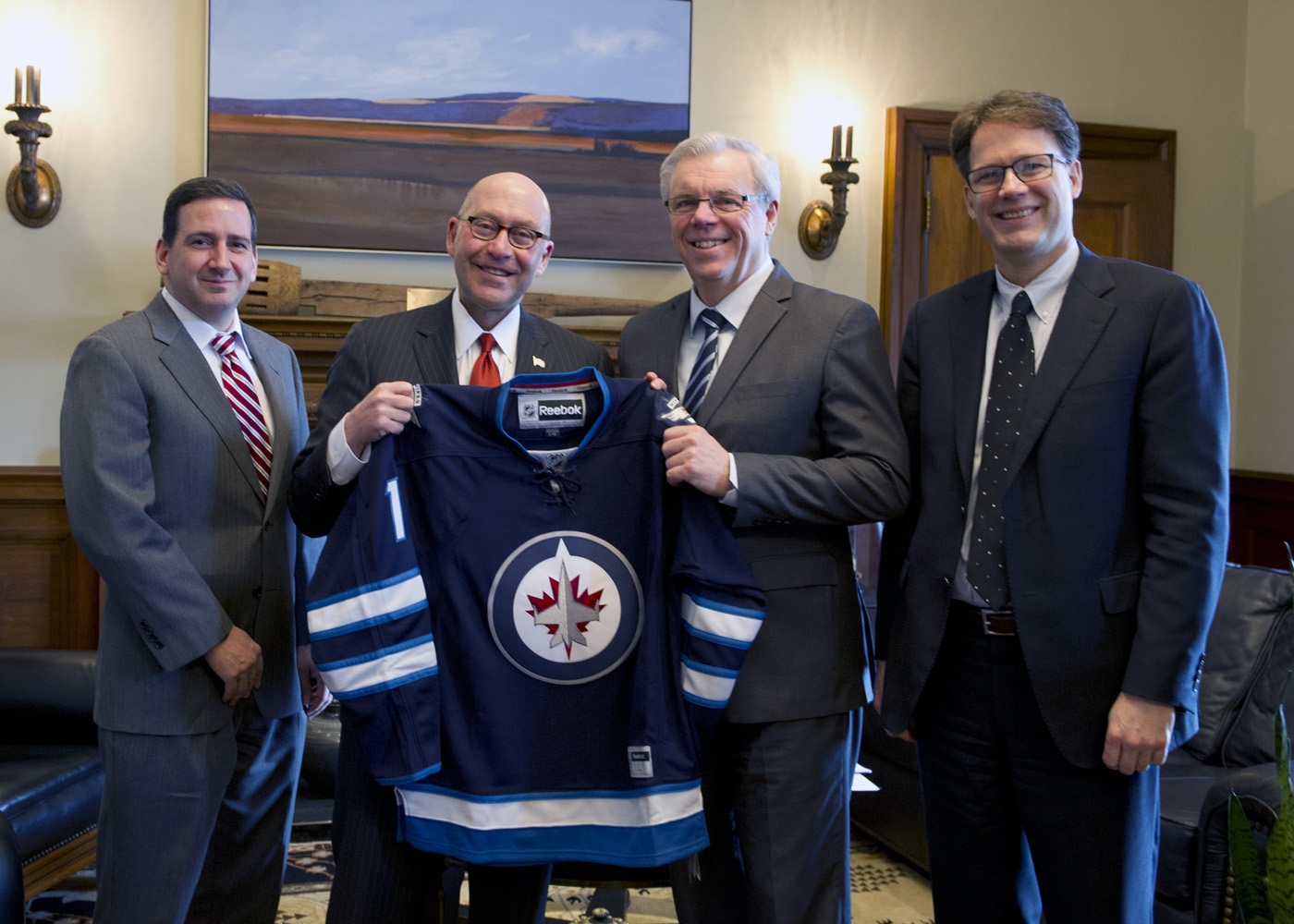Beginning in 1936 as the “International American Hockey League”, the American Hockey League (the “AHL”) serves as the premier development league for the NHL. Depending on the contract type (discussed below), NHL teams will pull players from the AHL when needed and send players back down when not. It also serves as a good developmental step for many NHL teams’ younger prospects. While originally created with the predominant focus of developing players for the NHL, the AHL now largely focuses on its own profit generation as a league. The balance of independence makes the NHL AHL relationship quite interesting.
It is common from time to time to see NHL teams switching affiliations with their AHL teams. This recently happened when the Carolina Hurricanes switched their AHL affiliation from the Charlotte Checkers to the Chicago Wolves. This leads to a lot of questions about how the NHL AHL relationship truly works.
The NHL AHL Relationship
As leagues, the AHL and NHL operate separately with their own commissioners and executives, teams, players’ unions, and boards. While separate entities, these leagues have to act together accordingly. The relationship between these leagues is largely represented by NHL teams affiliating with AHL teams. These affiliations provide a farm system to house and develop the NHL teams’ prospects and call ups in case of injuries.
There are also many specific examples of these leagues acting in accordance.
1. NHL CHL Agreement
One example is the agreement the NHL has with the Canadian Hockey League (Canada’s premier junior hockey league). Under this agreement, NHL players under age 20 that were drafted out of the CHL may only play in the NHL or must be loaned back to the CHL. This is why NHL prospects from the CHL cannot play in the AHL until age 20 but NHL prospects from European leagues can.
2. Collective Bargaining Agreements
Likewise, there is an understanding between the NHL’s and the AHL’s Collective Bargaining Agreements (“CBA”) as to how player contracts and rights are handled. For example, under the AHL’s CBA players in the AHL on NHL contracts are bound by the terms of the NHL contract. The AHL’s CBA does not bind these players if such provisions conflict with the terms of the NHL contract.
Arrangements Between NHL and AHL Teams
As mentioned above, the actual relationship between the NHL and the AHL comes in the form of affiliations. Generally, this affiliation arrangement comes in one of two ways: a single owner or separate owners.
1. Single Owner Arrangement
Sometimes an NHL team’s owner owns the AHL team it is affiliated with as well. The San Jose Sharks operate under this type of arrangement. The Sharks are owned by San Jose Sports and Entertainment Enterprises, LLC (“SJSEE”). SJSEE also owns the Sharks’ AHL affiliate, the San Jose Barracuda, and operates the SAP Center where the Sharks and Barracuda currently play. While the Sharks and Barracuda both fall under the ownership and ultimate direction of SJSEE, they operate as separate entities. The Las Vegas Golden Knights also operate with their AHL affiliate in a similar manner.
The Single Owner Arrangement
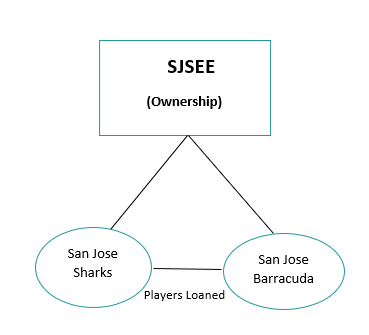
a. Revenues and Profits
Each team would likely handle its own revenues and expenses with ultimate profits or losses flowing to the ownership entity. Depending on how they run the entire organization, the ownership entity could utilize different cost and profit sharing arrangements. Areas such as staff and coaching expenses, equipment, travel expenses etc. would all need to be arranged within the ownership entity. The type of contract the player has determines whether the NHL or AHL team pays that player’s salary (see below). Even though the NHL or AHL team may be responsible for the salary, keep in mind that ultimately the expense would flow through to the ownership entity. This is more or less the case with every expense but there could be tax or other reasons for specifically allocating revenues and expenses to each team.
b. Advantages and Disadvantages of this Relationship
The advantage of this relationship is that it does allow the ownership entity to exercise more control over the AHL organization if it chooses to. This could lead to an increased focus on player development and less on the statistical success of the AHL team. In addition, usually under this arrangement both the NHL and AHL teams are located close by which may reduce travel expenses for player transactions. However, some research has shown that the proximity of the AHL and NHL teams has little effect on AHL attendance.
The downside to this arrangement is that the ownership entity will be ultimately responsible (financially and other) for both the NHL and AHL teams under its umbrella. With less of a focus on the AHL team’s statistical success, that team may suffer from reduced profits. However, some research shows shockingly that an AHL team’s winning percentage does not greatly affect attendance. As this ownership arrangement seems to be a trend now, the added responsibility may be worth the benefit of control.
2. Separate Owners Arrangement
This single owner arrangement is not always the case. When an ownership entity does not own the NHL and the affiliated AHL team, the relationship is not like a parent subsidiary relationship but more like a partnership under the restrictions and understandings between the leagues.
The NHL and AHL teams have separate owners. The AHL team will enter into an affiliation agreement with the NHL team for a certain amount of years. Note that if an NHL team does not have an affiliation agreement in place it may loan players to an AHL team affiliated with another NHL team.
The Carolina Hurricanes of the NHL and the Chicago Wolves of the AHL operate under this separate owners arrangement. While Tom Dundon is seen as the “owner” of the Hurricanes, he is actually the majority owner of Hurricanes Holdings, LLC which owns the Hurricanes and operates PNC Arena where the Hurricanes play. Rosemont Hockey Partners, LP owns the Wolves. The Hurricanes and Wolves entered into a three year affiliation agreement in 2020 for an NHL/AHL affiliation. Hurricanes Holdings, LLC and Rosemont Hockey Partners, LP do not have any other legal relationship outside of that between the Hurricanes and the Wolves.
The Separate Owners Arrangement
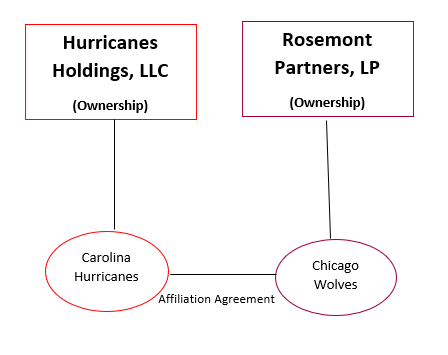
a. Revenues and Expenses
There could be certain cost sharing arrangements depending on the structure of the deal but generally the two teams would act independent of each other when it comes to operations, revenues and expenses. It is obviously important for the management groups of both teams to have an understanding when it comes to player development and transfers, but the actual business remains largely separate. Absent an alternate agreement, each ownership group would be responsible for its team’s own coaches and staff, arenas (leased or owned), equipment, etc. The player’s type of contract dictates who pays his salary (seen below).
b. Advantages and Disadvantages of this Relationship
The advantage to this type of relationship is that each ownership entity will generally only have responsibility for its own NHL or AHL team. If the AHL team is operating poorly the NHL team’s ownership entity is less attached and can walk away once the affiliation agreement is over.
A disadvantage of this arrangement from the NHL team’s perspective is that the ownership entity of the AHL team may be more concerned with its AHL team winning than on player development. This was allegedly why the St. Louis Blues ended their affiliation with the Chicago Wolves. This is not necessarily guaranteed to happen but is a risk.
The Players
A confusing but important aspect of NHL and AHL affiliations is how certain players are handled between the leagues. Let’s say that a player is performing really well in the AHL. That AHL team’s NHL affiliate has some injuries. Easy solution, the NHL team just pulls that player from the AHL, right? Maybe so…maybe not. Who is actually responsible for paying that player his contractually obligated salary? Again…it depends. The type of contract a player signs and who the player signs with largely dictates the answers to these questions.
1. Contracts
An NHL Standard Players Contract (“SPC”) can come in two different forms. It can be what is known as a “one-way” or a “two-way” contract, as dictated by the NHL’s CBA and the SPC.
a. One-Way NHL Contract
A one-way contract means the player is making X amount, no matter if that player is playing in the NHL or the AHL. It is subject to the NHL’s salary limitations and is paid by the NHL team. If the player is loaned to the AHL, the NHL team still has to pay the salary but may get salary cap relief based on a formula involving that salary amount.
b. Two-Way NHL Contract
A two-way contract is one in which the player makes X amount while playing in the NHL but Y amount while playing in the AHL (or any other league). The NHL amount is subject to NHL salary limitations while the AHL amount is subject to AHL salary limitations. The NHL team is on the hook for the actual payment of the salary but will get salary cap relief for the entire amount of the salary while the player is loaned to the AHL.
In either a one-way or two-way NHL contract, the player is contractually obligated to the NHL team and not the AHL team. If the NHL switches affiliations, that player goes to the new AHL team affiliated with the player’s NHL team. This wouldn’t happen during the season so it wouldn’t be like the player was traded to a new AHL team while actively playing midseason.
c. AHL Contracts
There are also players who sign an AHL contract. These players can only play on the AHL team and cannot be called up by the affiliated NHL team unless given a separate contract by that NHL team. The AHL team pays their salaries and they stay with that AHL team if the NHL team switches affiliations. Those players could also be on AHL-ECHL contracts that have similar characteristics between those leagues as a player on a NHL contract.
2. Loan Arrangements
There are other types of arrangements and transactions that can control the players as well. For starters, technically speaking, NHL players are “loaned” to the affiliated AHL teams. Even though there may be common ownership or an affiliation agreement with a certain AHL team, there are instances where NHL players are loaned to a different AHL team. The NHL team pays this player and his interest remains that NHL team’s property.
3. PTOs and ATOs
Professional tryout agreements (“PTO”) and amateur tryout agreements (“ATO”) also depend on who the contract is between. Because they are usually limited in their duration, you don’t really see players traded or teams switching affiliations while players are under a PTO or ATO agreement. They can be with the NHL or the AHL team. The team that the agreement is with is responsible for the payments to the player. The main difference between the PTO and ATO agreements are that a PTO is for a player that is already a “pro” whereas an ATO is for a player coming out of college or juniors.
4. Player Trades
Trading players also depends on that player’s contract. If a player on an NHL contract gets traded to another NHL team, that player then plays on the new NHL team and that NHL team’s AHL affiliate (unless loaned to a different AHL team). However, if a player is on an AHL contract and traded between AHL teams, he goes with that new AHL team with no connection to any NHL team. If a player on a NHL contract is traded between AHL teams (technically loaned), he remains the property of the NHL team.
This happened in 2016 when the Carolina Hurricanes’ Zach Boychuck was traded by their AHL affiliate, the Charlotte Checkers, for Andrew Miller, who was playing for the AHL’s Bakersfield Condors but under contract with the Edmonton Oilers. While the players swapped AHL teams, their original NHL teams retained their rights (i.e. Boychuck with Carolina and Miller with Edmonton).
Another recent example of seeing some of these conditions in one transaction involved the Carolina Hurricanes trading Cliff Pu to the Florida Panthers for Tomas Jurco in 2019. The trade was not as simple as Pu for Jurco. In two separate transactions, the Hurricanes traded Pu to the Panthers for future considerations and the Panthers’ AHL affiliate, the Springfield Thunderbirds, traded Jurco to the Hurricanes’ AHL affiliate, the Charlotte Checkers, for future considerations. Pu was on an NHL contract while Jurco was on an AHL contract. Jurco went to the Checkers but the Hurricanes could not call him up unless they gave him an NHL contract or PTO. Pu went to the Thunderbirds but could be called up by the Panthers because he was on an NHL contract. This is why the future considerations came into play.
The table below shows how these arrangements generally apply.
| Type of Contract | What Leagues Can they Play | Who Pays | Where Player Plays if NHL/AHL Affiliation Switched | If traded, Which Team Do they Play |
| NHL One-Way | NHL, AHL | NHL | NHL team and new AHL affiliated team | New NHL team and new AHL affiliated team |
| NHL Two-Way | NHL, AHL | NHL | NHL team and new AHL affiliated team | New NHL team and new AHL affiliated team |
| AHL | AHL | AHL | Same AHL team | New AHL team |
| Professional Tryout | NHL, AHL | NHL or AHL | NA | NA |
| Amateur Tryout | NHL, AHL | NHL or AHL | NA | NA |
| Loan | NHL, AHL | Loaning team | NA | NA |
Conclusion
As seen herein, the relationship between the NHL and AHL can be more complicated than meets the eye. There is really not a one size fits all answer to many questions surrounding these relationships. However, even with this complexity, the AHL still serves as the premier development league for the NHL and a great stomping ground for many star NHL players today.
Post image attribution: By TheAHL, CC BY 2.0 https://creativecommons.org/licenses/by/2.0, via Wikimedia Commons

